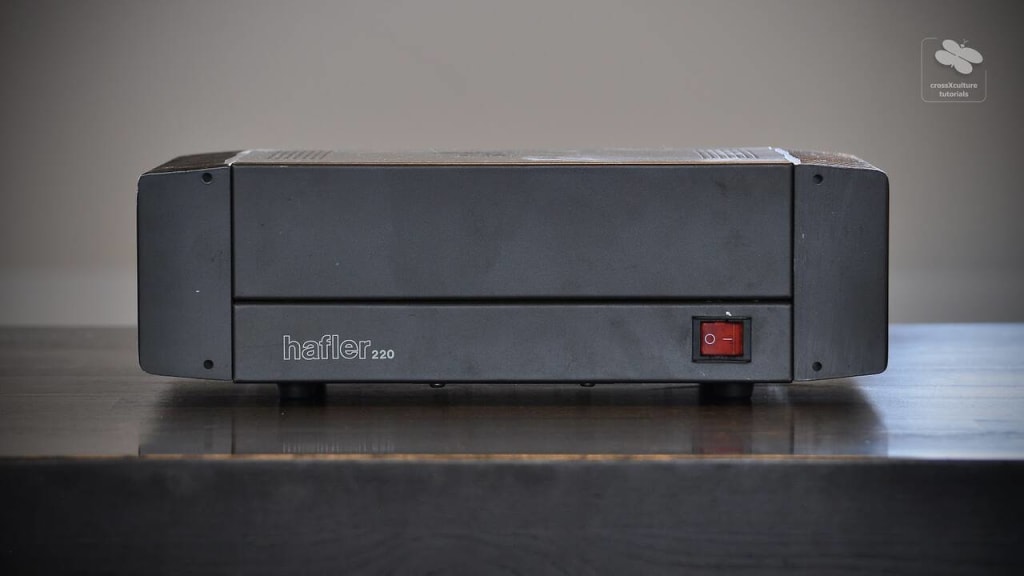Hafler DH-220
Published: 26/06/2020
Manufacturing date: 1984
Author: Karsten Hein
Category: Gear & Review
Tag(s): Power Amplifiers
There was a time when my good friend Luigi was bringing HiFi gear by our house for testing on a regular basis. And although there were lots of interesting discoveries to be made, somehow the devices did not strike a chord with us to the extent that we actually wanted to own them. One day, as I was climbing up the staircase from an evening teaching classes, I could hear music playing in the living room that sounded very realistic, even from a distance. Whatever this is, I was thinking to myself taking the last few steps, this is going stay. The system Luigi had set up for us was a Hafler combo consisting of the DH-110 preamplifier and the 60 watts DH-120 power amplifier. And its musicality was beyond anything we had heard at the time. When I later asked my wife at which point she knew that this would stay, she said that she had already heard it was very special from the kitchen - which is about thirty feet down the hall.
There are not many amplifiers capable of winning over our hearts from 30 feet away with such unanimous vote and certainly not at a price tag that most people are able to afford. Because of the obvious qualities of the Halfer, Luigi decided to purchase the 115 watts DH-220 and had it readjusted and fitted with new caps. The class-A portion of the amplifier was increased in the process, which has a positive impact on sound and leads to greater heat dispersion. I think you can literally fry an egg on this unit. At twelve kilos, the little amp feels like a solid piece of metal. The heat sinks are massive, and with this much class A-power that is probably good as it is. For an amplifier of this caliber, distortion figures are very low at any frequency. The below specs show THD at 1 kHz.
From my own experience I know that the DH-220 can be quite a princess, in the sense that it does not play with everybody. Some time ago we had borrowed it from Luigi to test it on our smaller system. In this scenario it had to play with some mediocre preamp and mid-fi speakers. The result was less than pleasing, and we soon returned the amp to look for something more appropriate. I was therefore surprised when Luigi insisted that I give this amp a second chance, now that all our other components had gradually been upgraded. In the current scenario the DH-220 was to replace the Citation Twelve Deluxe, a power amp that we have come to enjoy. And the playing partners were a Lenco L75 turntable, the Restek V1 pre, and Tannoy DC6t speakers at 8 ohms.
We gave the Citation a final listen and then hooked up the DH-220 for comparison. The improvement in this scenario was immediately audible even though the amp was still warming up. The slight dreaminess of the Citation was gone, music now had a more intense and realistic dimension to it which became especially striking when playing live recordings. Whereas the Citation had caressed the listener, the Hafler had a straightness and insistence to it that was familiar to me from some Quad amplifiers. The DH-220’s midrange is tonally very accurate and at that pleasingly broad. Its bass lines are powerful and controlled which develops into a pleasing fullness of sound. Spatial representation is highly accurate and piano notes are flung deep into the room. The Halfer played so well that we were able to remove the weights that I had placed on top of each speaker for better imaging and could pull the speakers further into the room without losing foundation. We will certainly keep this amp around for a while to enjoy the new dimension in sound. The Hafler DH-220 is well worth exploring. Wherever this amplifier fits in, it is going to be very hard to beat.
Specifications
- Power output (RMS, 8 ohms): 2 x 115 watts
- Transistor Type: Hitachi Mosfet
- Frequency response (15 watts, +/-0.5 dB): 6 - 60,000 Hz
- Frequency response (1 watt, -3 dB): 2 - 160,000 Hz
- Total harmonic distortion: 0,0025%
- Signal to noise ratio: >100 dB
- Damping factor: 300:1
- Crosstalk: 85 dB
- Rise time: 2,5 uS
- Weight: 12 Kg
- Country of manufacture: U.S.A.
- Year: 1984 - 1990





